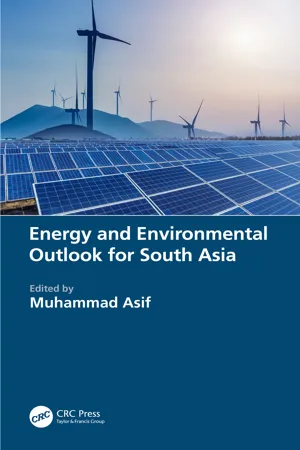
- 267 pages
- English
- ePUB (mobile friendly)
- Available on iOS & Android
Energy and Environmental Outlook for South Asia
About This Book
South Asia constitutes a key geography in the world today considering its large population and related daunting energy and environmental challenges. Many countries in the region are faced with a growing gap between energy demand and local resources, resulting in an increased dependence on imports. According to the International Energy Agency (IEA), the energy demand in South Asia will grow at a rate more than double that of the world average in the coming decades. This book addresses the critical subject of energy and environmental outlook for South Asia and presents the wider challenges and the responses at the national and regional level.
Features:
-
- Discusses and addresses the ongoing energy and environmental challenges faced by almost a quarter of the global population
-
- Includes dedicated chapters for each country and presents analysis and recommendations by regional experts
-
- Examines how deteriorating air quality and persistent natural disasters are severe environmental challenges for the region
-
- Discusses the implications of global warming and climate change for South Asia
-
- Includes practical case studies throughout
Energy and Environmental Outlook for South Asia will benefit a wide range of stakeholders from various fields including but not limited to energy, environment, economics, national security, and sustainable development. It also serves as a valuable resource for academics, researchers, analysts, policymakers, and representatives of utilities, industry, professional bodies, financial institutions, think tanks, and developmental organizations to better plan their initiatives, activities, and policies. It will help countries in the region and also those around the world by learning from shared experience, and ideally by collaborating for energy and environmental prosperity.
Frequently asked questions
Information
1
Introduction
- 1.1Energy, Environment, and Sustainable Development
- 1.2South Asia in Perspective
- 1.3Energy and Environmental Challenges
- 1.4Regional Geopolitics and Conflicts
- 1.4.1Territorial Disputes
- 1.4.2Water Disputes
- 1.5Structure of the Book
- References
1.1 Energy, Environment, and Sustainable Development

Sustainable Development Goal | Description |
|---|---|
SDG 6: Clean Water and Sanitation | Ensure availability and sustainable management of water and sanitation for all |
SDG 7: Affordable and Clean Energy | Ensure access to affordable, reliable, sustainable and modern energy for all |
SDG 11: Sustainable Cities and Communities | Make cities and human settlements inclusive, safe, resilient and sustainable |
SDG 12: Responsible Consumption and Production | Ensure sustainable consumption and production patterns |
SDG 13: Climate Action | Take urgent action to combat climate change and its impacts |
SDG 14: Life Below Water | Conserve and sustainably use the oceans, seas and marine resources for sustainable development |
SDG 15: Life on Land | Protect, restore and promote sustainable use of terrestrial ecosystems, sustainably manage forests, combat desertification, and halt and reverse land degradation and halt bio... |
Table of contents
- Cover
- Half Title
- Title Page
- Copyright Page
- Dedication
- Contents
- Forewords
- Preface
- Editor
- Contributors
- Chapter 1 Introduction
- Chapter 2 Afghanistan’s Energy and Environmental Scenario
- Chapter 3 An Overview of Energy Scenario in Bangladesh: Current Status, Potentials, Challenges and Future Directions
- Chapter 4 100% Renewable Energy Strategy: Bhutan’s Energy and Environmental Perspective
- Chapter 5 Sustainable Energy and Environmental Outlook: Indian Perspective
- Chapter 6 Energy and Environmental Development in Maldives
- Chapter 7 Energy Security in the Context of Nepal
- Chapter 8 Pakistan’s Energy Transformation Pathway and Environmental Sustainability
- Chapter 9 Energy, Environment and Sustainable Development Futures in Sri Lanka
- Chapter 10 South Asian Dual Challenges: Energy and Environment
- Chapter 11 Conclusion
- Index